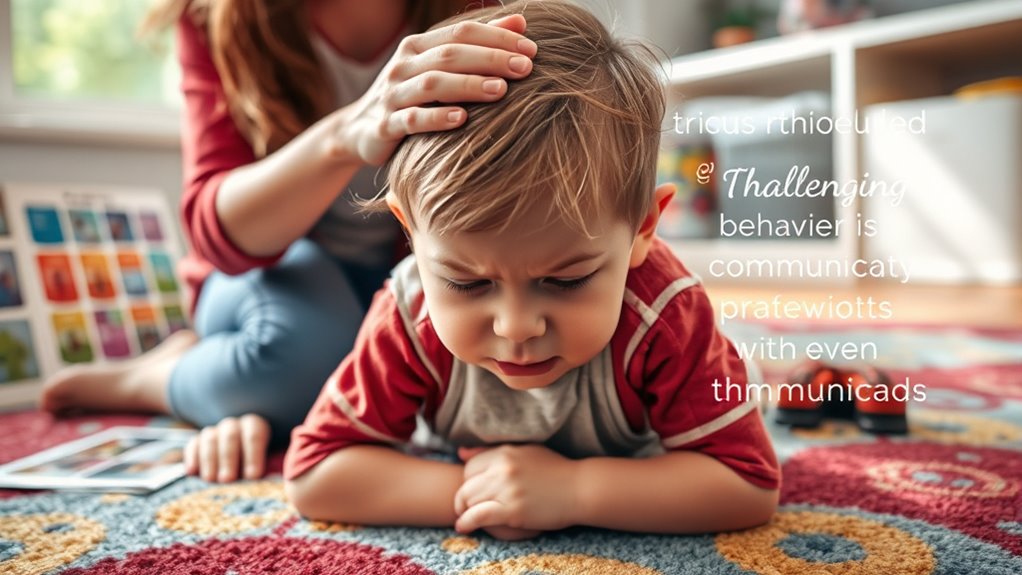Understanding triggers behind challenging behaviors involves recognizing various factors like physical discomfort, sensory overload, communication difficulties, and environmental changes. You should watch for signs like agitation or withdrawal, and notice patterns related to routines or past experiences. Addressing emotional needs and unmet desires for independence also matter. Collaborating with support systems helps uncover deeper causes. If you keep exploring, you’ll discover effective ways to manage and support these behaviors more successfully.
Key Takeaways
- Recognize physical discomfort, sensory overload, communication difficulties, emotional stress, and environmental changes as common triggers.
- Observe behavioral cues and signs to identify early indicators of internal or external triggers.
- Understand that unresolved health issues or trauma can significantly influence challenging behaviors.
- Modify environments and routines to reduce sensory overload and environmental stressors.
- Collaborate with caregivers and professionals to develop personalized strategies addressing specific triggers.
Recognizing Physical Discomfort and Health Issues

Physical discomfort and health issues often trigger challenging behaviors because individuals may not be able to communicate their pain or discomfort effectively. When someone feels unwell, their usual ways of expressing needs might not work, leading to frustration and acting out. Recognizing signs like sudden agitation, withdrawal, or changes in sleep or appetite can indicate underlying health problems. It’s important to contemplate recent illnesses, injuries, or chronic conditions that might cause discomfort. If you notice a sudden shift in behavior, check for signs of pain—such as grimacing or guarding certain areas. Addressing physical health issues promptly can prevent behaviors from escalating. Additionally, understanding how air purifier technology is implemented can help ensure that health monitoring devices remain trustworthy and secure. Incorporating health monitoring devices that detect physical discomfort early can significantly improve intervention outcomes. Being aware of remote monitoring capabilities can further enhance early detection and response. Always approach with empathy, as challenging behaviors may be a person’s way of signaling that something is wrong physically.
Identifying Sensory Overload and Sensory Processing Challenges

You may notice signs of sensory overload, like increased agitation or covering your ears, which indicate sensory processing challenges. Common triggers include loud noises, bright lights, or crowded spaces that can overwhelm your senses. To support yourself, try strategies like creating quiet spaces or using sensory tools to help manage these overloads effectively. Additionally, understanding how AI in Education can contribute to personalized learning may provide a sense of stability during stressful times. Monitoring credit scores and understanding credit card terms can also help reduce financial stress during challenging moments. Recognizing the importance of animated movies in emotional storytelling can sometimes help you process feelings and find comfort.
Signs of Sensory Overload
Sensory overload occurs when the brain struggles to process incoming sensory information, leading to noticeable behavioral and emotional responses. You might see signs like increased agitation, covering your ears or eyes, or withdrawing from the environment. Other indicators include pacing, fidgeting, or shouting, as these are ways your body tries to cope. You may also notice physical symptoms such as sweating, rapid heartbeat, or feeling overwhelmed. Sometimes, your responses can be more subtle, like a glazed look or difficulty focusing. Recognizing these signs early can help you take steps to reduce sensory input or find a quiet space. Understanding these cues allows you to manage sensory overload more effectively and prevent it from escalating into a full-blown meltdown.
Common Sensory Triggers
Identifying common sensory triggers is essential for understanding why sensory overload occurs. You might notice that loud noises, bright lights, or strong smells can overwhelm your senses, leading to challenging behaviors. Certain textures, like rough fabrics or sticky surfaces, also contribute to sensory discomfort. Visual stimuli such as busy environments or flashing screens can become overwhelming quickly. Additionally, changes in temperature or unexpected touch might trigger sensory processing challenges. Recognizing these triggers helps you pinpoint what causes overload, so you can better manage or avoid these situations. Keep in mind that sensory triggers vary from person to person. Being aware of your specific sensitivities allows you to take proactive steps to reduce overload and support your well-being.
Strategies for Support
Recognizing when sensory overload is happening is the first step toward providing effective support. Pay attention to signs like covering ears, avoiding certain textures, or becoming irritable. Once you notice these cues, create a calming environment by reducing noise, dimming lights, or offering a quiet space. Use sensory tools such as noise-canceling headphones or textured fidget items to help them self-regulate. Communicate calmly and reassure them that they’re safe. It’s important to respect their need for sensory breaks and avoid overwhelming stimuli. Consistently observe their responses and adapt your approach as needed. Supporting sensory processing challenges involves patience and understanding, helping them regain control and feel secure. Your proactive efforts can markedly reduce distress and prevent challenging behaviors from escalating.
Understanding Communication Difficulties and Frustration

When someone struggles to communicate their needs or feelings, frustration often builds, leading to challenging behaviors. You might notice they become upset, withdrawn, or act out. This happens because they’re unable to express themselves clearly, which leaves them feeling powerless. Understanding this can help you respond more effectively. Consider these key points:
- Communication barriers can cause feelings of isolation and helplessness.
- Limited vocabulary or language skills make expressing needs difficult.
- Nonverbal cues may be misunderstood or go unnoticed.
- Frustration can escalate when attempts to communicate are ignored.
- Patience and alternative methods of communication help reduce tension.
- Using engaging narratives and immersive soundscapes, as seen in National Geographic Channel Voiceover Ads, can facilitate understanding and connection.
- Incorporating communication support strategies can further bridge gaps and foster effective interactions.
- Recognizing and addressing communication barriers early can prevent escalation of problematic behaviors.
- Addressing underlying speech and language development issues early on can significantly improve communication outcomes and reduce behavioral challenges.
Exploring Environmental Triggers and Changes in Routine

Environmental triggers and changes in routine can considerably impact behavior, especially for individuals who thrive on predictability. Unexpected shifts or unfamiliar surroundings may cause confusion, anxiety, or frustration. Recognizing these triggers helps you create supportive environments. For example, loud noises, crowded spaces, or sudden schedule changes can trigger challenging behaviors. To better understand, consider this table:
| Trigger Type | Example | Impact |
|---|---|---|
| Environmental Noise | Construction sounds | Overstimulation, agitation |
| Routine Disruption | Missed activities | Anxiety, frustration |
| New Environments | Visiting unfamiliar places | Confusion, stress |
Being aware of these triggers allows you to plan and modify routines, reducing stress and promoting positive behaviors.
Addressing Emotional and Social Stressors

Emotional and social stressors can considerably influence challenging behaviors, often acting as internal triggers that are less visible but equally impactful. These stressors may stem from feelings of anxiety, frustration, or social rejection, which can build up silently. Recognizing and addressing these triggers helps you create a supportive environment. To do this effectively, consider:
- Validating feelings without judgment
- Teaching healthy coping strategies
- Encouraging open communication
- Reducing social pressures where possible
- Building trust through consistent routines
- Utilizing tools like portable camping toilets to ensure comfort and reduce stress during outdoor activities
Being aware of diverse designs in indoor environments can also help foster a more inclusive and calming atmosphere, reducing potential stressors. Additionally, understanding symptoms of breast cancer can promote early detection and reduce anxiety related to health concerns, contributing to a more secure and supportive environment. Incorporating mindfulness techniques, such as deep breathing exercises, can further assist in managing internal triggers and promoting emotional stability. Recognizing the importance of attention to detail in creating supportive environments ensures that subtle stressors are not overlooked, helping to maintain emotional well-being.
Noticing Unmet Needs and Desire for Independence

Recognizing when someone’s needs are unmet or they’re craving independence is essential for understanding challenging behaviors. When a person feels their basic needs aren’t satisfied—like needing rest, comfort, or control—they may act out or become resistant. Similarly, a strong desire for independence can lead to frustration if they’re unable to make choices or do things on their own. You might notice signs like withdrawal, irritability, or repeated attempts to assert control. Paying close attention to these signals helps you understand the underlying causes of their behavior. Instead of reacting with frustration, you can respond by offering appropriate support or opportunities for autonomy. Meeting these unmet needs and respecting their desire for independence can reduce challenging behaviors and foster trust.
Examining Past Experiences and Trauma-Related Factors

Understanding what lies behind challenging behaviors often requires exploring a person’s past experiences. Trauma or difficult events can deeply influence how someone reacts today. These experiences may create triggers that lead to emotional outbursts or withdrawal. Recognizing this connection helps you approach behaviors with empathy and patience. Consider that:
- Past trauma can cause heightened sensitivity to certain stimuli
- Unresolved feelings may resurface during stressful moments
- Childhood experiences shape current emotional responses
- Repeated negative events build patterns of behavior
- Trauma can distort perceptions of safety and trust
- The profound impact of life lessons shared by fathers can influence resilience and coping strategies in adulthood.
- Understanding trauma responses can aid in developing more effective support strategies.
- Increasing awareness of trauma triggers can help in creating supportive environments that promote healing.
- Recognizing behavioral patterns rooted in trauma can facilitate more compassionate interventions.
Observing Patterns and Situational Contexts

You can start by noticing recurring behaviors and the situations that trigger them. Pay attention to patterns in how and when challenging behaviors happen, and look for common environmental factors. Analyzing the sequence of incidents helps you understand what leads up to these behaviors and how to address them effectively. Additionally, recognizing dog names associated with specific behaviors can offer insights into your pet’s personality and help tailor your approach. Incorporating self-awareness techniques can further enhance your understanding of these behavioral triggers and improve your response strategies. Being aware of juice detox side effects can also inform your approach to managing stress or unexpected reactions during behavioral interventions.
Recognizing Behavioral Patterns
By paying close attention to behavioral patterns and the contexts in which they occur, you can uncover valuable insights into why challenging behaviors happen. Recognizing these patterns helps you identify recurring triggers and understand the underlying needs or emotions behind the actions. Look for consistent situations that precede behaviors, such as specific times of day or activities. Notice if certain emotions, like frustration or boredom, seem to influence responses. Tracking these patterns allows you to predict and potentially prevent future outbursts.
- Repeated behaviors in similar situations
- Common emotional states before incidents
- Triggers linked to specific routines
- Responses that tend to escalate behavior
- Consistent environmental or social factors
Identifying Environmental Triggers
Environmental factors often play a significant role in triggering challenging behaviors, especially when specific settings or situations consistently precede incidents. By observing these patterns, you can identify common environmental triggers, such as noisy environments, crowded spaces, or sudden changes in routines. Pay attention to the timing and location of behaviors, noting if they occur during shifts or particular activities. Keep a detailed log of these instances, including what was happening before the behavior started. Sometimes, a specific setting or sensory input might overwhelm the individual, leading to challenging responses. Recognizing these environmental cues helps you implement strategies to modify or avoid certain situations, creating a calmer environment that minimizes triggers and supports better behavior management.
Analyzing Incident Sequences
Analyzing incident sequences involves carefully examining the order and context of events leading up to challenging behaviors. By observing how situations unfold, you can identify patterns and triggers that might not be immediately obvious. This process helps you see the connection between specific actions and reactions, revealing underlying causes. When reviewing incidents, consider the environment, emotional state, and interactions involved. Look for commonalities across events to predict and prevent future challenges.
- Recognize recurring patterns to anticipate behaviors
- Understand the timing and sequence of events
- Identify emotional or environmental triggers
- Note any changes in routine that influence reactions
- Use insights to develop proactive strategies for support
Collaborating With Support Systems to Uncover Underlying Causes

Collaborating with support systems is essential for uncovering the underlying causes of challenging behaviors. By working closely with teachers, family members, therapists, and other professionals, you gain diverse perspectives that can reveal patterns or triggers you might overlook alone. Regular communication helps create a thorough understanding of the individual’s history, routines, and environment. Together, you can share observations, discuss concerns, and develop collaborative strategies. This teamwork ensures that interventions address root causes rather than just symptoms. Building strong relationships with support systems fosters trust and openness, making it easier to identify subtle cues or stressors contributing to behavior. Ultimately, this collaborative approach enhances your ability to create targeted, effective solutions that promote positive change.
Frequently Asked Questions
How Do Triggers Differ Across Various Age Groups and Developmental Stages?
You might notice that triggers differ across age groups and developmental stages. For young children, triggers often involve sensory overload or frustration with communication. As children grow, social pressures and academic stress can become triggers. Adults may face triggers like workplace stress or relationship issues. Recognizing these differences helps you tailor your responses, addressing each stage’s unique challenges to better support behavior management and emotional well-being.
What Role Do Cultural Backgrounds Play in Interpreting Challenging Behaviors?
You might find it surprising, but cultural backgrounds greatly influence how you interpret challenging behaviors. Your cultural beliefs shape what you see as acceptable or problematic, causing different reactions to the same behavior. You could overlook underlying issues if you don’t consider cultural context. By understanding these differences, you help create a more compassionate response, fostering better communication and support. Recognizing this influence allows you to approach behaviors with greater empathy and awareness.
How Can I Differentiate Between a Trigger and a Temporary Reaction?
To tell a trigger from a temporary reaction, pay attention to patterns. A trigger consistently causes a specific response, like loud noises provoking anxiety. A temporary reaction is often a one-time response to a current situation, like frustration from a bad day. Observe if the behavior repeats with the same stimulus over time. Recognizing these patterns helps you identify triggers versus fleeting reactions, guiding more effective support strategies.
What Are Effective Strategies for Preventing Trigger Escalation?
Imagine you’re in the wild west, trying to prevent a duel before it sparks. To stop triggers from escalating, stay calm and observe early signs of distress. Use proactive strategies like clear communication, offering choices, and maintaining a calm environment. Consistently reinforce positive behavior and set boundaries. By addressing issues early, you’re less likely to see reactions escalate, ensuring smoother interactions and a more peaceful setting.
How Can Technology Assist in Identifying and Managing Triggers?
Technology can help you identify and manage triggers by tracking behaviors and environmental factors through apps or sensors. You can set alerts for patterns that lead to challenging behaviors, enabling you to intervene early. Wearable devices can monitor physiological signs like heart rate, signaling stress before escalation. Data analysis from these tools helps you understand triggers better, allowing you to develop personalized strategies to prevent or lessen challenging behaviors effectively.
Conclusion
By tuning into these triggers, you become a detective uncovering hidden clues behind challenging behaviors. Like a skilled navigator, you steer through the storm, guided by understanding and patience. Each insight lights a path toward calmer seas and brighter days. Remember, recognizing these signals transforms chaos into clarity, turning turbulent waters into a steady voyage of connection and support. Your awareness is the compass that leads to compassion and change.









